NIH’s Early Homes
From N.Y. to D.C. to Bethesda
From its inception, the National Institutes of Health has had responsibilities, scientific knowledge, and ambitions that have increased faster than its real estate. Before moving to its current location in Bethesda, Maryland, in 1938, the NIH and its predecessor, the Hygienic Laboratory, occupied three other sites, each one bigger than the last. One of these sites, on Navy Hill in Washington, D.C., has been added to the National Register of Historic Places.
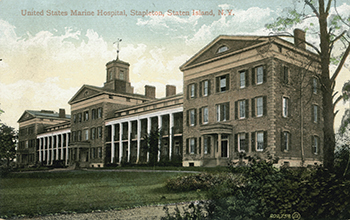
CREDIT: IRMA AND PAUL MILSTEIN DIVISION OF UNITED STATES HISTORY, LOCAL HISTORY AND GENEALOGY, THE NEW YORK PUBLIC LIBRARY
The Hygienic Laboratory was established in 1887 at the United States Marine Hospital (Stapleton, Staten Island, New York) just as the germ theory of infectious disease was taking hold. The lab to Washington, D.C., in 1891.
The United States Public Health Service originated in 1798 as the Marine Hospital Service (MHS), a branch of the Treasury Department that cared for sick and injured U.S. merchant seamen. The Hygienic Laboratory, part of the MHS, was established in 1887 at the Marine Hospital (Stapleton, Staten Island, New York) just as the germ theory of infectious disease was taking hold.
The MHS hoped that the new field of bacteriology, spurred by the theory’s acceptance, would help the MHS clinicians charged with examining newly arrived immigrants—and the crews on the ships that brought them—for cholera and yellow fever. Laboratory Director Joseph J. Kinyoun quickly proved the usefulness of the laboratory by demonstrating the presence of the Vibrio cholera bacterium among passengers on the steamship Alesia. But the laboratory consisted of one room and one employee—Kinyoun. Supervising Surgeon General John B. Hamilton (served from 1879 to 1891) soon began petitioning for an entire building.
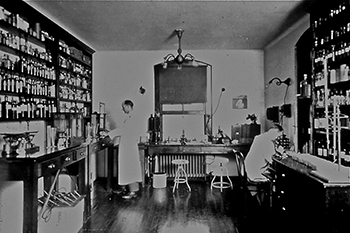
CREDIT: NIH
An inside look at the Hygienic Laboratory when it was located in the Marine Hospital Service facility at Stapleton Hospital (Staten Island, New York). Kinyoun’s microscope can be seen in the center on the bench by the window.
In 1891, the laboratory moved to Washington, D.C., where it took over the top floor of the Butler Building (corner of B and Third Street, SE), which had been the mansion of Benjamin Butler, a Union general during the Civil War and later a congressman and a governor of Massachusetts. Kinyoun and other MHS officers conducted studies here to distinguish variola virus from vaccinia virus, produced diphtheria antitoxin and rabies vaccine, and conducted water- and air-pollution research. Kinyoun also studied the newly discovered plague bacillus and was the first American to prepare and test smallpox immune serum in humans. It’s no wonder he wrote in an 1896 report, “A laboratory of this character should not be placed in a building used for public offices. It is not only disagreeable to the other occupants, but in no little degree dangerous.”
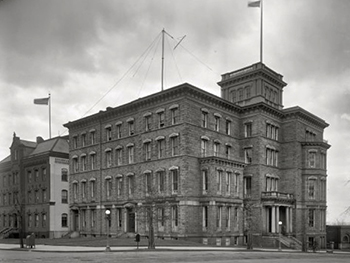
CREDIT: LIBRARY OF CONGRESS
The Butler Building served as the Marine Hospital Service headquarters in the Capitol Hill area of Washington, D.C. The whole top floor belonged to the Hygienic Laboratory (1891–1904). The building was torn down in 1929 and was replaced by the Longworth Building, which contains offices for the U.S. House of Representatives.
Finally, Congress listened to Kinyoun’s and the surgeon general’s repeated pleas and in 1901 authorized $35,000 to erect an entire laboratory building and an animal facility. They would be constructed on Navy Hill, a five-acre section of the federal reservation that had been occupied by the United States Naval Observatory from 1844 to 1893. (The Naval Museum of Hygiene was housed in the former observatory from 1894 to 1902, and then the Naval Medical School moved in.)
The North Building, as the laboratory’s building was called, was located at 25th and E Streets NW and overlooked the Potomac riverfront industrial zone that included asphalt works, the Christian Heurich Brewery, and the malodorous Civil War–era wooden building of the municipal dog pound. In the North Building, the laboratory was to pursue investigations of infectious diseases and matters pertaining to public health.
While construction progressed in 1902, Congress solidified the laboratory’s role as the federal government’s center of research with two acts. The first changed the name of the MHS to the “Public Health and Marine Hospital Service” (PH-MHS). The second—the Biologics Control Act—made the laboratory responsible for regulating the commercial production of “biologics,” the sera and vaccines produced as a consequence of the new science of bacteriology. To support the added mandate of public health, the laboratory created divisions of chemistry, pharmacology, and zoology in addition to the existing division of “pathology and bacteriology” (considered one field at the time).

CREDIT: OFFICE OF NIH HISTORY AND STETTEN MUSEUM
The North Building on Navy Hill opened in March 1904 and was used by the Hygienic Laboratory (later renamed the National Institute of Health) until NIH’s move to Bethesda, Maryland, in 1938. The building was destroyed in 1963 to make room for the E Street Expressway.
In March 1904, the 13 members of the laboratory moved into the North Building. Space was cramped, however, and the begging for more room began anew. Surgeon General Walter Wyman, who oversaw the PH-MHS) declared that the laboratory needed a shed for experimenting with disinfecting gases; an animal breeding house and an associated heating plant; a carpentry and blacksmith shop; and storage for wagons and other equipment. In addition, he recommended that separate rooms be provided to study tetanus, tuberculosis, plague, and diphtheria; to monitor vaccines and sera; and to house delicate analytical balances. He also complained in his annual report that the grounds were unsightly and full of weeds and not in keeping with the PH-MHS’s position and dignity and contrasted poorly with the Navy’s well-tended grounds.
In the meantime, the Naval Medical Hospital, with four pavilion-style wards, was being constructed (1903–1908) behind the old Naval Observatory. The hospital complex included quarters for sick officers and nurses, a contagious disease building, and administrative structures.
A $75,000 extension to the North Building was completed in 1909, but in 1912, Congress expanded the laboratory’s mission again—adding investigations into noninfectious disease—and shortened PH-MHS’s name to the “Public Health Service” (PHS).
Laboratory Director Milton Rosenau, who had replaced Kinyoun in 1899, pointed out that the laboratory’s responsibilities of regulating biologics, investigating infectious and noninfectious diseases, and addressing other public-health concerns required yet another building. Rosenau also renewed the plea for additional funds to build a proper animal house because the guinea pigs, horses, goats, and rabbits in the existing facilities were susceptible to epidemics themselves. A stone house for the animals was finally erected in 1915.
During World War I (1914–1918), the focus of the PHS and the Hygienic Laboratory shifted to manufacturing vaccines, evaluating industrial hygiene, and maintaining sanitation at the numerous military campsites around the United States. George W. McCoy became the lab’s director in 1915 and holds the record for longest-serving director (1915–1937). Scientific contributions under his leadership included a vaccine against Rocky Mountain spotted fever and, later, the discovery that rickettsiae could be grown in the yolk sacs of fertile hens’ eggs, an advance that enabled the mass production of a vaccine against epidemic typhus to protect Allied troops in World War II.
The laboratory also investigated the 1918 influenza epidemic; conducted fluoride and nutrition studies in the 1930s that later resulted in the addition of fluoride and nutrients to water and food; and established how certain diseases were transmitted by milk and developed a Milk Code for sanitation.
To accommodate the PHS’s new responsibilities, the South Building was constructed in 1919—next to the North Building—for the divisions of zoology, chemistry, and pharmacology. The South Building was state-of-the-art, like the North Building before it, and was fireproof. But tragedy struck Hygienic Laboratory researchers in 1930 during an outbreak of parrot fever, or psittacosis. The disease was so contagious, and the methods of the time so ineffectual at isolating contagious material, that 11 laboratory workers became ill, and one died. McCoy forbade anyone to work on the investigation except himself. Eventually the building had to be temporarily closed and fumigated with cyanide gas.
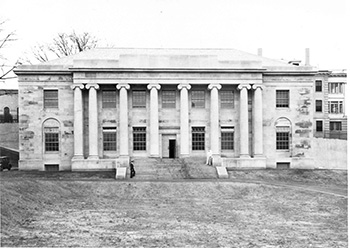
CREDIT: OFFICE OF NIH HISTORY AND STETTEN MUSEUM
The Administrative Building (later renamed the East Building) was used by NIH from 1934 to 1938. During World War II, the Office of Strategic Services, which was the predecessor of the Central Intelligence Agency, was headquartered here.
In May 1930, the Ransdell Act renamed the Hygienic Laboratory the “National Institute of Health” and gave NIH the ability to establish fellowships for research into basic biological and medical problems. (NIH became the National Institutes of Health—plural—in 1948.) The Ransdell Act also provided funds for more construction. This time a new laboratory building and the Administration Building (renamed the East Building in 1954) were built on Navy Hill. The new laboratory building became the South Building, while the old South Building was renamed the Central Building. The new South Building held the Division of Pathology and Bacteriology in a space larger than those of the Central and East Buildings combined. The classically designed limestone East Building housed the director’s office and library.
Once NIH had expanded into five buildings (including the animal facility) and the number of employees had risen to 150, the feeling of camaraderie lessened unfortunately, and informal conversations about science as well as close collaborations were less likely to occur. And McCoy, as director, felt separated from what went on in the state-of-the-art laboratories furnished with the latest in scientific equipment.
And still the NIH was outgrowing its space. When Luke and Helen Wilson offered their 45-acre estate in Bethesda, Maryland, to the U.S. government, the PHS seized the opportunity to once again expand NIH’s physical plant. By 1938, the NIH had moved to the Bethesda campus where it is today. The steps of Navy Hill’s East Building became a convenient spot for the scientists in the various divisions to line up and pose for photographs before they departed for Bethesda.
NIH moves out, CIA moves in: In 1942, four years after NIH moved away from the Navy Hill Campus, the Naval Medical Hospital and the Naval Medical School, which had been on Navy Hill since 1903, moved out. All their hospital operations were transferred to the National Naval Medical Center in Bethesda, Maryland. During World War II, several of the vacant Navy Hill buildings were used by the Office of Strategic Services (OSS) under William “Wild Bill” Donovan. His OSS, which ended operations in 1945, was the predecessor to the Central Intelligence Agency (CIA), which began in 1947. The CIA headquarters relocated to Langley, Virginia, in 1961. In 1963, to accommodate construction of the E Street Expressway, a large chunk of Navy Hill was demolished including the North Building and the animal building. The U.S. Navy Bureau of Medicine and Surgery, which moved to Navy Hill in 1942, remained there until 2012, when it moved to Falls Church, Virginia. The U.S. Department of State has been using the E Street campus to house a variety of operations since 1987.
In 2016, OSS and CIA alumni succeeded in getting the buildings added to the National Register of Historic Places as the “E Street Complex (Office of Strategic Services and Central Intelligence Agency Headquarters).” The historical interpretation of the site is devoted to Donovan and the OSS, although the State Department is the current occupant of the remaining buildings. In 2017, it was through the Office of the State Department Historian that NIH staff members from the Office of NIH History and Stetten Museum were able to tour the site, which had been off-limits since NIH left nearly 80 years ago. The Office of NIH History will be working with the State Department Historian to rectify the gap in interpretation of the site. To learn more, read the application to the National Historic Registry at http://www.osssociety.org/pdfs/oss_nr_final_to_hpo.pdf.
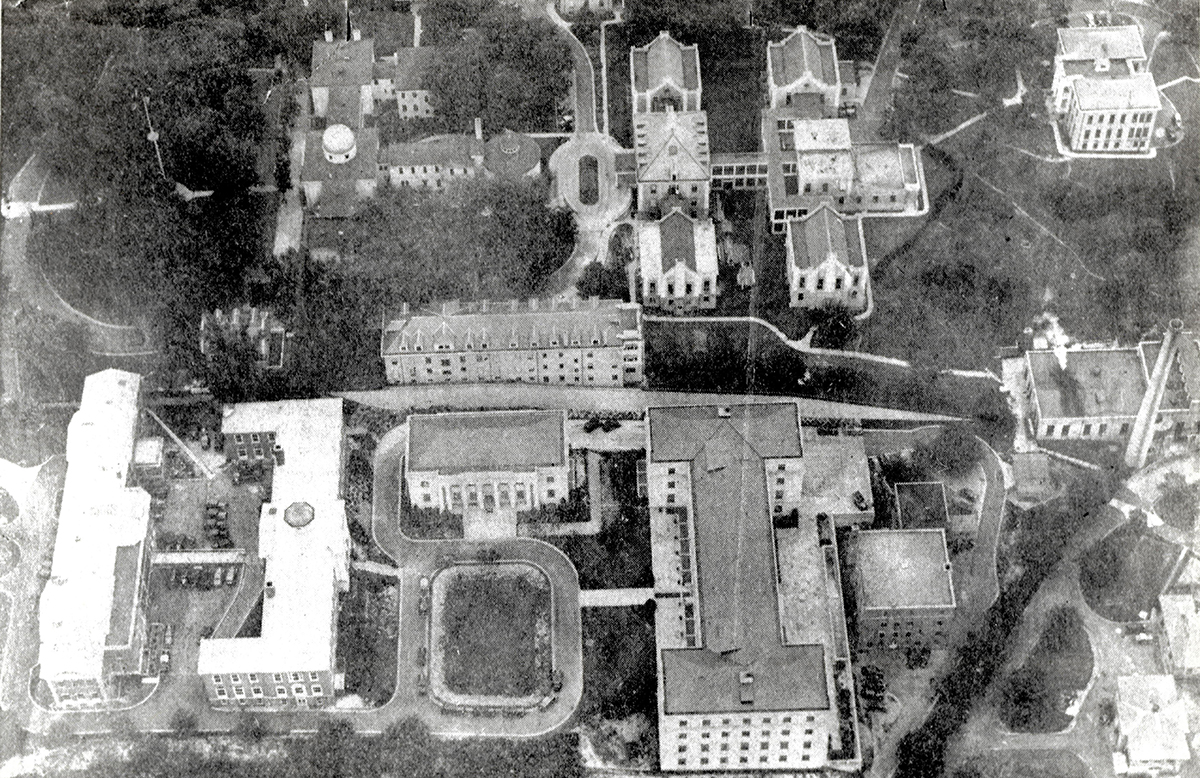
CREDIT: OFFICE OF NIH HISTORY AND STETTEN MUSEUM
NIH buildings on the Navy Hill campus as viewed from the Goodyear blimp Enterprise (1936). Buildings (lower half of photograph, from left): North Building; Central Building (old South Building); East Building (formerly the Administration Building); South Building. Behind the East Building (from left): The Old Naval Observatory, the Navy Hospital, and wards and housing.
United States Naval Observatory
Before Microscopes, There Were Telescopes
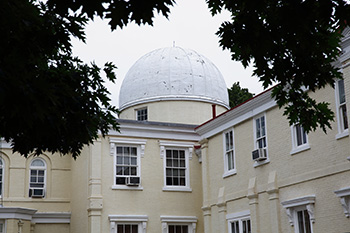
PHOTO BY BILL BRANSON, NIH
The United States Naval Observatory on Navy Hill (1844–1893), now unoccupied, made significant contributions to astronomy in the 1800s.
Lying between 23rd and 25th Streets, and E Street and the Potomac River, the site originally called Potomac Hill was a bastion of 19th century science. In 1844, the building now known as the Old Naval Observatory was completed. The American Prime Meridian was set here in 1850 and used as the reference point for establishing the boundaries of many western states. In 1877, the moons of Mars were discovered by a Naval assistant astronomer—one of the major astronomical discoveries of the 19th century. Naval researchers contributed to the Transit of Venus expeditions in 1874 and 1882, and they also attempted to measure the speed of light. By 1893 the observatory needed additional space and moved to its current location at 3450 Massachusetts Avenue, NW, in Washington, D.C.
Further reading about Kinyoun and the Hygienic Lab
NIH Catalyst November–December 2012 issue
“Dr. Joseph Kinyoun The Indispensable Forgotten Man”
This page was last updated on Friday, April 8, 2022
